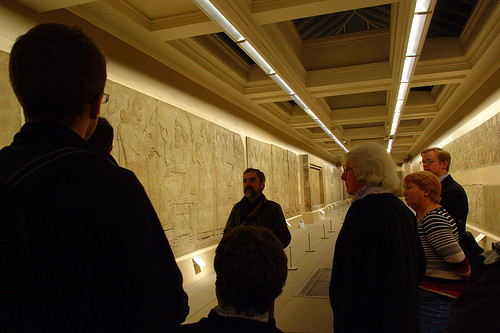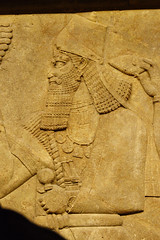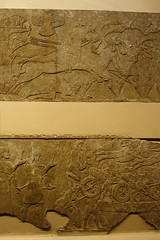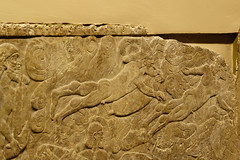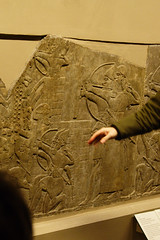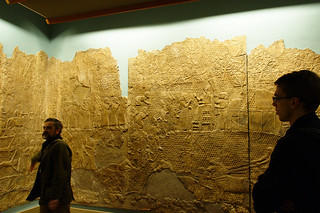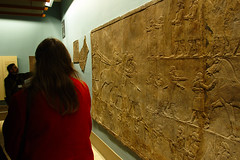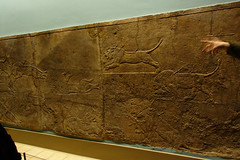A couple of weeks ago we had a day out in London visiting the British Museum. During the day we mainly went to see their El Dorado exhibition (which I’ll write up later) and in the evening we went to two gallery talks at the Members’ Open Evening (one of which is what I’m talking about here, the other one will be tomorrow). My photos related to both these talks are up on flickr here.
The first of the two talks was about the Assyrian reliefs that the museum has on the ground floor. The curator, Nigel Tallis, took us round 3 of the rooms, talking about both the art and what it tells us about the Assyrian Kings (and about their methods of warfare, hence the title of the talk).
The first room has reliefs from the Northwest Palace in Nimrud (in modern Iraq) and is the earliest known example of these types of reliefs from Assyria – previously they had painted reliefs with much the same subject matter. Tallis told us this was an example of how the Assyrian Kings liked to demonstrate their greatness by emphasising their embrace of new technology & arts, they’d seen reliefs in other lands and now they wanted them themselves.
The last two of those photos also illustrate the army, and thus by extension the King embracing new technology. There’s a scene of the army crossing a river, and you can see the soldiers using inflated bladders as float aids. And you can see in the siege scene that the defenders have tried to set the Assyrian army on fire, but the Assyrians are pumping water to put out the flames.
The next room has the reliefs from the Southwest Palace of Sennacherib, which are later in date and more complex in style. In contrast to the Nimrud reliefs the text on these one includes captions explaining what the scenes are showing. The text on the Nimrud ones is several repetitions of a standard text explaining how glorious the king is.
The scenes here tell the story of the siege of Lachish, a city in Judah. Tallis told us this is an unusual situation from the ancient world where we have both sides of the story – these reliefs tell the Assyrian side, and the Bible tells the Jewish side. The reliefs tell the whole story of the siege, and the capture of the citizens of the city (and what happened to those that were punished). In the photo above the King is sitting on a hill overlooking the action. Tallis pointed out several features that suggest that the artists who created the scenes were actually present at the battle, sketching bits for later use. And he said that archaeologists have figured out where the battle took place, by using the relief and matching the landscape up. So it’s partly a realistic representation, but it’s important remember it’s also symbolic. And again it displays the King endorsing & using new technology (and you can see where the artists are stretching their repertoire too).
The last room he took us through was the one with the royal lion hunt reliefs. These are not war per se, but involve a lot of the same sorts of representation and mix of realism and symbolism. The lions as they are shot and die are very realistically depicted, again it looks like the artist has seen this rather than just been told about it. But the King is shown as larger than life – a relatively new development, earlier reliefs had him the same size as other people.
Also crossing the boundaries between reality & symbolism is the whole event itself – the lion hunt was a real thing that happened, but it was very much staged. The lions were captured and the whole hunt took place within an enclosed area. One of the photos above shows the lions being released into the arena. There’s also a scene of the King killing a lion with a knife – there’s a series of these scenes, like a cartoon strip, showing a lion feigning death then rearing up to attack a servant before the King bravely steps in and finishes it off. Now this may’ve been a thing that actually happened, but it’s also a propaganda piece for the King – if you look at the pose of the actual kill it’s set up to look exactly like one of the royal symbols, which will not’ve been a coincidence!
This was a fascinating talk, I’ve looked at these reliefs several times but there was a lot I’d not noticed or not realised the significance of.
